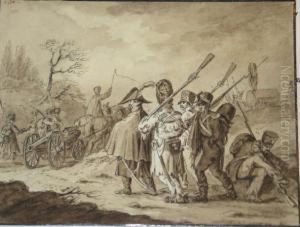Franz Von Habermann Paintings
Franz von Habermann, also known as Franz Xaver Habermann, was a German artist born in 1721 in Glatz, Silesia, which is now Kłodzko, Poland. He was primarily known for his work as an engraver and etcher during the Rococo period, which was characterized by its ornate and decorative style. Habermann's works were often intricate, demonstrating a high level of skill and attention to detail that was typical of the Rococo movement's aesthetic.
Habermann received his artistic training in Augsburg, a city with a rich tradition in the arts, particularly in printmaking. He was a student of the renowned engraver Johann Jakob Haid. Under Haid's mentorship, Habermann honed his skills and developed his own style. He later became an independent master and set up his own workshop, contributing to the artistic scene in Augsburg and beyond.
Throughout his career, Habermann produced a wide range of engravings, including portraits, religious subjects, and decorative pieces. His work often featured pastoral scenes, allegories, and mythological subjects, which were popular among the patrons of the time. Habermann's engravings were not only appreciated for their artistic merit but also played a role in the dissemination of the Rococo style across Europe, as prints were a primary means of circulating art and ideas at the time.
Franz von Habermann's influence as an engraver extended to his role as an educator. He taught and mentored other artists, thus perpetuating the craft of engraving. His legacy in the world of printmaking is marked by the high quality of his work and his contribution to the Rococo style.
Franz von Habermann passed away in 1796 in Augsburg. Although he may not be as widely known as some of his contemporaries, his work remains an important part of the history of European printmaking. Habermann's engravings are still studied and collected today, appreciated for their elegance, craftsmanship, and as a reflection of the artistic tastes of the 18th century.
